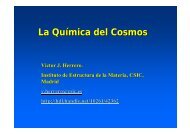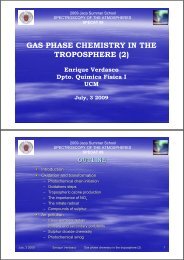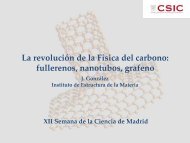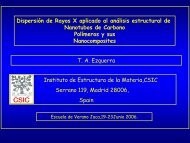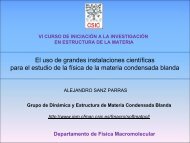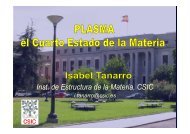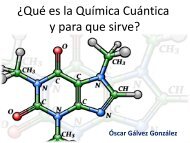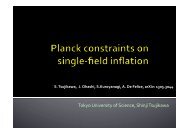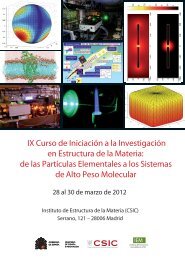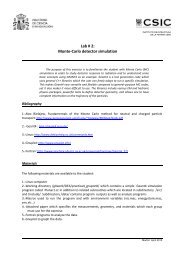ANNUAL REPORT 2011 - Instituto de Estructura de la Materia
ANNUAL REPORT 2011 - Instituto de Estructura de la Materia
ANNUAL REPORT 2011 - Instituto de Estructura de la Materia
You also want an ePaper? Increase the reach of your titles
YUMPU automatically turns print PDFs into web optimized ePapers that Google loves.
subdominant corrections (proportional to the logarithm of the area) are different for the statistical (counting) entropyand the true thermodynamical entropy. This fact is relevant not only within the context of LQG but also for otherapproaches to quantum gravity such as string theories.The methods of LQG have also been employed to analyze the quantum realm in cosmological systems, in the fieldof specialization that is nowadays known as loop quantum cosmology (LQC). In particu<strong>la</strong>r, during <strong>2011</strong> we haveimplemented and compared the so-called improved dynamics prescriptionsthat exist for LQC in the literature,studying homogeneous and isotropic spacetimes containing a massless sca<strong>la</strong>r field. We have checked that all theseprescriptions lead to the same qualitative results for semic<strong>la</strong>ssical states in such cosmological spacetimes, and thatthe physical behavior is in fact simi<strong>la</strong>r even for states which are not so semic<strong>la</strong>ssical or in regimes where thequantum effects start to be not totally negligible, although there exist discrepancies. What is more important, not allof these prescriptions have the same properties from the viewpoint of numerical computations. In particu<strong>la</strong>r, aprescription introduced by us seems especially simple to implement and reduces consi<strong>de</strong>rably the time ofcomputation. We have optimized the co<strong>de</strong>s of our numerical library for simu<strong>la</strong>tions in LQC in or<strong>de</strong>r to take ful<strong>la</strong>dvantage of the features of this specific prescription.During this year we have also successfully applied loop techniques to inhomogeneous cosmologies of the Gowdytype including a masless sca<strong>la</strong>r field, reaching for the first time a complete and consistent quantization in theframework of LQC for a mo<strong>de</strong>l with local <strong>de</strong>grees of freedom in the matter content and in the geometry. We have<strong>de</strong>veloped a proposal for a hybrid quantization of this mo<strong>de</strong>l, and implemented it to completion, proving theconsistency of the approach.The aim of this work has been manifold: a) to obtain an exact quantum <strong>de</strong>scription ofinhomogeneous cosmologies with matter fields that inclu<strong>de</strong>s effects of the loop quantum geometry, b) to <strong>de</strong>terminethe space of physical states and a complete set of physical observables, c) to prove that the quantum dynamics iswell posed, d) to <strong>de</strong>monstrate that the cosmological singu<strong>la</strong>rities are resolved in this framework, and e) to show thatone recovers the standard Fock quantization for the inhomogeneities in appropriate regimes for physical states.Moreover, restricting the analysis to the vacuum case, we have also discussed the effect of the inhomogeneities onthe Big Bounce that rep<strong>la</strong>ces the Big Bang singu<strong>la</strong>rity, using the effective theory associated with our exact quantummo<strong>de</strong>l. The analytical study has confirmed the qualitative robustness of the bounce. Numerical simu<strong>la</strong>tions haveshown that this robustness is also quantitative. Besi<strong>de</strong>s, this numerical analysis has <strong>de</strong>monstrated that the amplitu<strong>de</strong>sof the inhomogeneities do not change statistically in the bouncing process, except when they are small, case inwhich they seem to be en<strong>la</strong>rged by a kind of enhancing mechanism. This mechanism might exp<strong>la</strong>in the re<strong>la</strong>tively<strong>la</strong>rge amplitu<strong>de</strong> of primordial fluctuations if it is confirmed in more realistic cosmological mo<strong>de</strong>ls.In field like systems like this, which possess an infinite number of <strong>de</strong>grees of freedom, a severe problem are theambiguities found in the quantization process, which affect the final outcome in the quantum theory. In the case of aFock quantization, where one can reach a concept of particle for the field (at least to a certain extent), an importantpart of these ambiguities are those arising in the choice of a quantum representation. This problem is encountered instandard quantum field theory on curved backgrounds, but also in the case of the quantization of theinhomogeneities within the hybrid scheme put forward by us in the framework of LQC. In stationary settings,symmetry or energy criteria are known to select a unique Fock quantization. Quite remarkably, we have been able toprove recently that, even in non-stationary settings, one can pick up a unique Fock quantization by introducing thecriteria of a) invariance of the vacuum un<strong>de</strong>r the symmetries of the field equations, and b) unitarity in the dynamicalevolution (with respect to an emergent time re<strong>la</strong>ted to area or volume elements). This uniqueness provi<strong>de</strong>s aconsi<strong>de</strong>rable robustness to the results of the quantization and its physical predictions. Strictly speaking, theuniqueness theorems reached so far apply to the case of sca<strong>la</strong>r fields on any compact spatial topology and in anyspatial dimension equal or smaller than three. Applications for an unambiguous quantization of perturbations incosmology are almost direct.Another research line that we have followed has been the analysis of Hawking radiation in a Schwarzschild b<strong>la</strong>ckhole as perceived by different observers. The method is based on the introduction of an effective temperaturefunction that varies with time. First we introduce a non-stationary vacuum state which mimics the process ofswitching on Hawking radiation in a stationary spacetime. Then, we analyse this vacuum state from the perspectiveof static observers at different radial positions, observers un<strong>de</strong>rgoing a free-fall trajectory from infinity, andobservers standing at rest at a radial distance and then released to fall freely towards the horizon. We find thatgeneric freely-falling observes do not perceive vacuum when crossing the horizon, but an effective temperature afew times <strong>la</strong>rger than the one that they perceived when started to free-fall. We exp<strong>la</strong>in this phenomenon as due to adiverging Doppler effect at horizon crossing. From a different perspective, we use the trans-P<strong>la</strong>nckian problem ofHawking radiation as a guiding principle in searching for a compelling scenario for the evaporation of b<strong>la</strong>ck holes orb<strong>la</strong>ck-hole-like objects. We argue that there exist only three possible scenarios, <strong>de</strong>pending on whether the c<strong>la</strong>ssicalnotion of long-lived horizon is preserved by high-energy physics and on whether the dark and compact astrophysicalobjects that we observe have long-lived horizons in the first p<strong>la</strong>ce. Along the way, we find that a) a theory withhigh-energy superluminar signalling and a long-lived trapping horizon would be extremely unstable in astrophysical49




